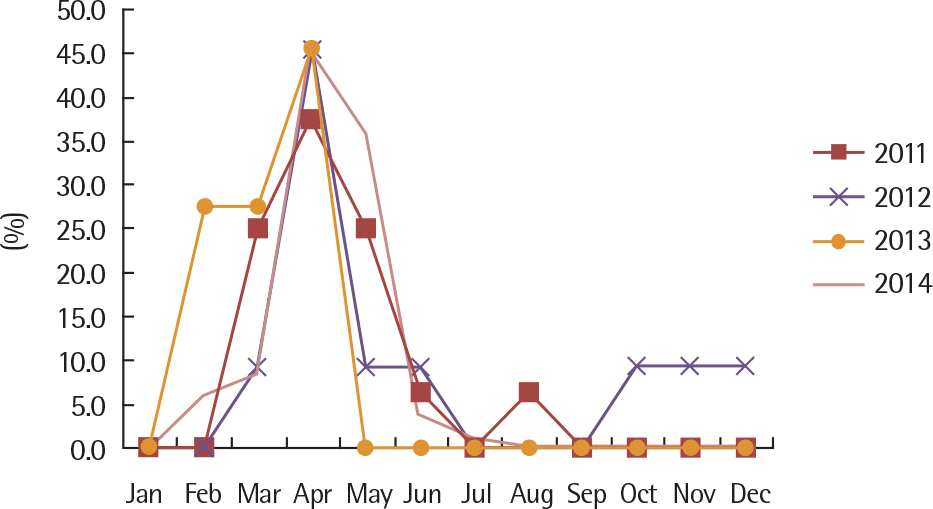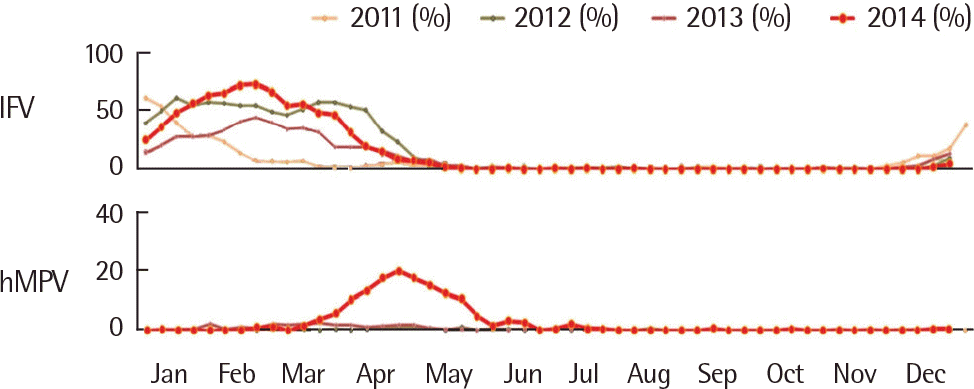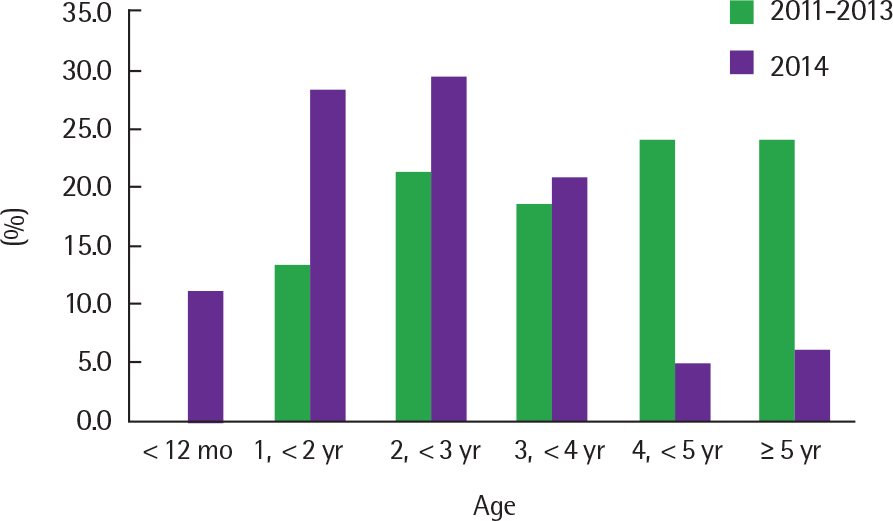Abstract
Purpose
This study was performed to investigate the epidemiologic and clinical features of human metapneumovirus (hMPV).
Methods
We performed realtime reverse transcription polymerase chain reaction with nasopharyngeal samples from 2,403 children who were hospitalized with acute respiratory infection. Then medical records of 120 children, who were diagnosed with hMPV respiratory infection between 2011 and 2014, were retrospectively analyzed retrospectively and compared to epidemiologic data on respiratory virus infection reported by Korea Centers for Disease Control and Prevention.
Results
We detected 120 hMPV-positive cases out of 1,723 virus-positive specimens (7.0%), which prevailed mostly in spring between March and May. Respiratory infection with hMPV was more common in female patients (55.0%) and hPMV infection was prevalent among children aged <5 years (80.8%). Coinfections with other respiratory viruses were observed in 34 patients of 120 hMPV-positive cases (28.3%), mostly with rhinovirus (52.9%). In addition, hPMV infection mostly presented with pneumonia (71.7%). Among 120 hMPV-positive patients during the recent 4 years, most (68.3%) were diagnosed in 2014. During 2011–2014, influenza virus infection was prevalent mainly from January to March, and hMPV infection started to appear just after the end of influenza virus outbreak.
Conclusion
In Korean children, hMPV was a common causative organism of viral pneumonia during the spring season. The hMPV infection pandemic was observed in 2014 and the clinical importance of hMPV has recently been increasing. Therefore, additional studies are required to define the epidemiology, disease characteristics caused by hMPV, and the cause of recent outbreak.
Go to : 
REFERENCES
1. Lopez AD, Mathers CD, Ezzati M, Jamison DT, Murray CJL. Global burden of disease and risk factorsed. Washington, DC: The International Bank for Reconstruction and Development/The World Bank;2006.
2. Jung BS, Oh JS, Cho B, Kim HH, Lee JS. A clinical study of respiratory tract infections in hospitalized children. Pediatr Allergy Respir Dis. 1996; 6:60–73.
3. Taussig L, Landau L. Pediatric respiratory medicine. 2nd ed.Philadelphia (PA): Mosby;2008.
4. Valero N, Larreal Y, Arocha F, Gotera J, Mavarez A, Bermudez J, et al. Viral etiology of acute respiratory infections. Invest Clin. 2009; 50:359–68.
5. Michelow IC, Olsen K, Lozano J, Rollins NK, Duffy LB, Ziegler T, et al. Epidemiology and clinical characteristics of community-acquired pneumonia in hospitalized children. Pediatrics. 2004; 113:701–7.

6. van den Hoogen BG, de Jong JC, Groen J, Kuiken T, de Groot R, Fouchi-er RA, et al. A newly discovered human pneumovirus isolated from young children with respiratory tract disease. Nat Med. 2001; 7:719–24.

7. Hamelin ME, Boivin G. Human metapneumovirus: a ubiquitous and long-standing respiratory pathogen. Pediatr Infect Dis J. 2005; 24(11 Suppl):S203–7.
8. Houben ML, Coenjaerts FE, Rossen JW, Belderbos ME, Hofland RW, Kimpen JL, et al. Disease severity and viral load are correlated in infants with primary respiratory syncytial virus infection in the community. J Med Virol. 2010; 82:1266–71.

9. Deffrasnes C, Hamelin ME, Boivin G. Human metapneumovirus. Semin Respir Crit Care Med. 2007; 28:213–21.

10. Kim YK, Kim JW, Wee YS, Yoo EG, Han MY. Clinical features of human metapneumovirus and respiratory syncytial virus infection in hospitalized children. Pediatr Allergy Respir Dis. 2009; 19:12–9.
11. Mejías A, Chávez-Bueno S, Ramilo O. Human metapneumovirus: a not so new virus. Pediatr Infect Dis J. 2004; 23:1–7.
12. Principi N, Bosis S, Esposito S. Human metapneumovirus in paediatric patients. Clin Microbiol Infect. 2006; 12:301–8.

13. Caracciolo S, Minini C, Colombrita D, Rossi D, Miglietti N, Vettore E, et al. Human metapneumovirus infection in young children hospitalized with acute respiratory tract disease: virologic and clinical features. Pediatr Infect Dis J. 2008; 27:406–12.
14. Boivin G, De Serres G, Côté S, Gilca R, Abed Y, Rochette L, et al. Human metapneumovirus infections in hospitalized children. Emerg Infect Dis. 2003; 9:634–40.

15. Bosis S, Esposito S, Niesters HG, Crovari P, Osterhaus AD, Principi N. Impact of human metapneumovirus in childhood: comparison with respiratory syncytial virus and influenza viruses. J Med Virol. 2005; 75:101–4.

16. McAdam AJ, Hasenbein ME, Feldman HA, Cole SE, Offermann JT, Riley AM, et al. Human metapneumovirus in children tested at a tertiary-care hospital. J Infect Dis. 2004; 190:20–6.

17. Chung JY, Han TH, Kim BE, Kim CK, Kim SW, Hwang ES. Human metapneumovirus infection in hospitalized children with acute respiratory disease in Korea. J Korean Med Sci. 2006; 21:838–42.

18. Park JS. Acute viral lower respiratory tract infections in children. Korean J Pediatr. 2009; 52:269–76.

19. Williams JV, Harris PA, Tollefson SJ, Halburnt-Rush LL, Pingsterhaus JM, Edwards KM, et al. Human metapneumovirus and lower respiratory tract disease in otherwise healthy infants and children. N Engl J Med. 2004; 350:443–50.

20. Chun JK, Lee JH, Kim HS, Cheong HM, Kim KS, Kang C, et al. Estab-lishing a surveillance network for severe lower respiratory tract infections in Korean infants and young children. Eur J Clin Microbiol Infect Dis. 2009; 28:841–4.

21. Yeom HH, Park JS, Jeong DJ, Kim CJ, Kim YB, Lee DH, et al. Human metapneumovirus infection in Korean children. Korean J Pediatr. 2006; 49:401–9.

22. Jartti T, van den Hoogen B, Garofalo RP, Osterhaus AD, Ruuskanen O. Metapneumovirus and acute wheezing in children. Lancet. 2002; 360:1393–4.

23. Khetsuriani N, Kazerouni NN, Erdman DD, Lu X, Redd SC, Anderson LJ, et al. Prevalence of viral respiratory tract infections in children with asthma. J Allergy Clin Immunol. 2007; 119:314–21.

24. Esper F, Martinello RA, Boucher D, Weibel C, Ferguson D, Landry ML, et al. A 1-year experience with human metapneumovirus in children aged <5 years. J Infect Dis. 2004; 189:1388–96.
25. Chano F, Rousseau C, Laferrière C, Couillard M, Charest H. Epidemiological survey of human metapneumovirus infection in a large pediatric tertiary care center. J Clin Microbiol. 2005; 43:5520–5.

26. Hendry RM, Pierik LT, McIntosh K. Prevalence of respiratory syncytial virus subgroups over six consecutive outbreaks: 1981-1987. J Infect Dis. 1989; 160:185–90.

Go to : 
Table 1.
Detection rate of hMPV by multiplex realtime polymerase chain reaction in nasopharyngeal aspirate
| Characteristic | 2011–2014 | 2011–2013 | 2014 |
|---|---|---|---|
| Total | |||
| Virus positive | 1,723 | 799 | 924 |
| hMPV positive | 120 (7.0) | 38 (4.8) | 82 (9.0) |
| March–May | |||
| Virus positive | 354 | 128 | 226 |
| hMPV positive | 96 (27.1) | 29 (22.7) | 67 (30.0) |
Table 2.
Demographic and clinical manifestations of human metapneumovirus infection




 PDF
PDF ePub
ePub Citation
Citation Print
Print





 XML Download
XML Download